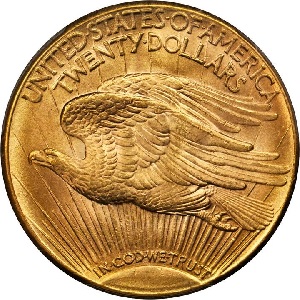1926-D Saint-Gaudens $20 Double Eagle
Production of the Saint-Gaudens $20 double eagle commenced in 1907 and continued through 1933. Many pieces from the 1920’s and 1930’s never left United States Treasury vaults, where they remained as backing for paper currency, although a small percentage were shipped across the Atlantic to finalize international transactions.(1)
In reviewing the generous mintages of the Saint-Gaudens double eagles, a novice collector might get the impression they should be fairly common coins worth only a bit more than their bullion content, yet some of them are very highly valued in the numismatic community.
The Gold Recall of 1933 resulted in the melting of virtually the entire supply of double eagles stored by the Treasury Department. Millions of gold coins were transformed into bars and eventually hidden away at Fort Knox in Kentucky.
During this process, some of the Saint-Gaudens coins were very nearly eliminated completely. One such date is the 1926-D double eagle. Despite an initial mintage of 481,000, less than 500 exist today.(2)
The rarity profiles during the 1940’s of numerous Saint-Gaudens double eagle dates look very different today. By the time the 1926-D made its first auction appearance in January 1946, it was believed to be one of the three rarest dates in the Saint-Gaudens series – the other two being the 1924-S and the 1926-S.(3)
Legendary dealer B. Max Mehl offered a 1926-D in a 1949 sale, describing the date as "the rarest of all Double Eagles of all Mints of all dates," surpassing in scarcity even the 1920-S, 1921, and 1927-D.
As the Saint-Gaudens double eagles gained in collector popularity, bags of the coins surfaced in Europe (where they had found safety from the Gold Recall) and made their way back to America during the early 1950’s.
The hoard discoveries on foreign soil altered assessments on true rarity. The 1924-S and 1926-S, once considered to be highly elusive, were actually relatively plentiful. However, dates like the 1920-S, 1921, 1926-D, and 1927-D were repatriated in very small numbers.(4)
The value of the 1926-D dipped in the 1950’s as a few examples arrived from their European refuge, but as time went on, the coin rose steadily in numismatic esteem. After many years of third party certification and population reports, we clearly see the 1926-D double eagle is well deserving of its accolades.
| Estimated survivors in all grades: 487 ?
The survivor estimate from PCGS represents an average of one or more experts' opinions as to how many examples survive of a particular coin in all grades. Survival estimates include coins that are raw, certified by PCGS, and certified by other grading services. Learn more at PCGS. |
| PCGS Rarity Scale: 6.0 ?
The 'PCGS CoinFacts Rarity Scale' assesses the relative rarity of all U.S. coins, based on estimated surviving examples. The scale runs from 1.0 to 10.0. The higher the number, the rarer the coin.
Learn more at PCGS. |
| Click HERE to check for availability on eBay** |
Preview of eBay selection:
 |
 |
| Trendline Avg = 21.42 | BETTER |
Historic Value Trend Charts:
| Last updated 10-9-24 | Return to Key Date Coin List | |
| Compare to Common Date Coin of Same Type | ||
|
|
||
| Download Charts to Your Computer | ||
Sources
1. Heritage Auctions. 1926-D $20. Jan 2010 Auction.
2. PCGS. 1926-D $20 (Regular Strike).
3. Heritage Auctions. 1926-D $20. Jan 2012 Auction.
4. Stack's Bowers Galleries. 1926-D Saint-Gaudens Double Eagle. Jun 2013 Auction.
**Many very fine coin dealers sell on eBay. At any point in time, there may be over one million search results for United States coins. This includes quite a few of the recommendations on our Key Date Coin List.
If you’re thinking about purchasing a rare coin, eBay is certainly worth a look. For your convenience, the links from this site to eBay are coded to bring up only coins certified by PCGS and NGC.
As is always, always the case, never buy a valuable coin from a seller whose trustworthiness cannot be verified. Learn more about this at our chapter Best Places to Buy Coins, which also has a section on doing business on eBay.
In the interest of full disclosure, Rare Coins 101 receives a small commission anytime someone connects to eBay from this site and purchases something.
Coin images by Stack's Bowers Galleries.


